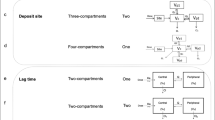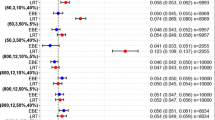Abstract
Clinical studies investigating relationships between D3 and 25OHD3 vary in dosing regimen, assays, demographics, and control of exogenous D3. This leads to uncertain and conflicting exposure-related associations with D3 and 25OHD3. To elucidate this parent-metabolite system, a PPK model was developed to predict mean D3 and 25OHD3 exposure from varied doses and administration routes. Sources of exposure variability related to metabolite baseline, weight, and assay type were explored. Specific search criteria were used in PUBMED to identify public source PK data pertaining to D3 and 25OHD3 in healthy or osteoporotic populations. Overall 57 studies representing 5395 individuals were selected, including 25 individual-level profiles and treatment-arm data. IV, oral, single and multiple dose data were used, with D3 and 25OHD3 dosing. A nonlinear mixed effects model was developed to simultaneously model PK dispositions of D3 and 25OHD3 (NONMEM v7.2), which were described by 2-compartment models with nonlinear and linear clearances, respectively. Proportional and additive assay variances were included on the 25OHD3 prediction. Unit-level random effects were weighted by treatment-arm size. D3 model estimates, relative to bioavailability were: maximum rate of metabolism (\(V{\rm max}\), 1.62 nmol/h), Michaelis–Menten constant (\(Km\), 6.39 nmol/L), central volume of distribution (\(Vc\), 15.5 L), intercompartmental clearance (\(Q\), 0.185 L/h), peripheral volume of distribution (\(Vp\), 2333 L/h), and baseline concentration (\({DBASE}\), 3.75 nmol/L). For 25OHD3 (\(m\) = metabolite): \(CLm\) = 0.0153 L/h, \(Vcm\) = 4.35 L, \(Vpm\) = 6.87 L, \(Qm\) = 0.0507 L/h. Simulations of 25OHD3 concentration indicated an inverse relationship between 25OHD3 baseline and response, as well as a less than proportional 25OHD3 response. Estimation of assay bias parameters suggested that HPLC–MS and RIA produced similar measurement results, whereas CPBA and CHEMI are over-predictive of 25OHD3 concentration, relative to HPLC–MS.





Similar content being viewed by others
References
Hagenau T, Vest R, Gissel TN, Poulsen CS, Erlandsen M, Mosekilde L, Vestergaard P (2009) Global vitamin D levels in relation to age, gender, skin pigmentation and latitude: an ecologic meta-regression analysis. Osteoporos Int 20:133–140
Wranicz D, Szostak-Węgierek J (2014) Health outcomes of vitamin D. Part II. Role in prevention of diseases. Rocz Panstw Zakl Hig 65(4):273–279
Christiansen C, Christensen MS, McNair P, Nielsen B, Madsbad S (1982) Vitamin D metabolites in diabetic patients: decreased serum concentration of 24,25-dihydroxyvitamin D. Scand J Clin Lab Investig 42:487–491
Issa T, Zantout C, Azar S (2015) Vitamin d replacement and type 2 diabetes mellitus. Curr Diabetes Rev 11(1):7–16
Hibler EA, Jacobs ET, Stone AD, Sardo CL, Galligan MA, Jurutka PW (2014) Associations between vitamin D-binding protein isotypes, circulating 25(OH)D levels, and vitamin D metabolite uptake in colon cancer cells. Cancer Prev Res 7(April):426–434
Davis C (2008) Vitamin D and cancer: current dilemmas and future research needs. Am J Clin Nutr 88:565S
Ruwanpathirana T, Reid CM, Owen AJ, Fong DPS, Gowda U, Renzaho AMN (2014) Assessment of vitamin D and its association with cardiovascular disease risk factors in an adult migrant population: an audit of patient records at a Community Health Centre in Kensington, Melbourne, Australia. BMC Cardiovasc Disord 14(1):1–8
Wöbke TK, Sorg BL, Steinhilber D (2014) Vitamin D in inflammatory diseases. Front Physiol 5(July):1–20
Brannon PM (2012) Key questions in vitamin D research. Scand J Clin Lab Investig 72(Suppl 243):154–162
IOM (Institute of Medicine) (2011) Dietary reference intakes for calcium and vitamin D. Committee to review dietary reference intakes for vitamin D and calcium. The National Academies Press, Washington, DC
Holick MF (2007) Vitamin D deficiency. N Engl J Med 357(3):3846–3847
Holick MF (2009) Vitamin D and health: evolution, biologic functions, and recommended dietary intakes for vitamin D. Clin Rev Bone Min Metab 7:2–19
Alshahrani F, Aljohani N (2013) Vitamin D: deficiency, sufficiency and toxicity. Nutrients 5:3605–3616
Lips PÃ (2006) Vitamin D physiology. Prog Biophys Mol Biol 92:4–8
DeLuca HF (2008) Evolution of our understanding of vitamin D. Nutr Rev 66(Suppl 2):S73–S87
Heaney RP, Davies KM, Chen TC, Holick MF, Janet Barger-Lux M (2003) Human serum 25-hydroxycholecalciferol response to extended oral dosing with cholecalciferol. Am J Clin Nutr 77:204–210
Food And Nutrition Board and Institue Of Medicine (1997) Dietary reference intakes for calcium, phosphorus, magnesium, vitamin D, and fluoride, no. 1. National Academy Press, Washington, D.C.
Malabanan A, Veronikis IE, Holick MF (1998) Redefining vitamin D insufficiency. Lancet 351(9105):805–806
Thomas MK, Lloyd-Jones DM, Thadhani RI, Shaw AC, Deraska DJ, Kitch BT, Vamvakas EC, Dick IM, Prince RL, Finkelstein JS (1998) Hypovitaminosis D in medical inpatients. N Engl J Med 338(12):777–783
Heaney RP, Dowell MS, Hale CA, Bendich A (2003) Calcium absorption varies within the reference range for serum 25-hydroxyvitamin D. J Am Coll Nutr 22(2):142–146
Holick MF, Siris ES, Binkley N, Beard MK, Khan A, Katzer JT, Petruschke RA, Chen E, De Papp AE (2005) Prevalence of vitamin D inadequacy among postmenopausal North American women receiving osteoporosis therapy. J Clin Endocrinol Metab 90(6):3215–3224
Ilahi M, Armas LAG, Heaney RP (2008) Pharmacokinetics of a single, large dose of cholecalciferol. Am J Clin Nutr 87(10):688–691
Vieth R (2005) Vitamin D, 2nd edn. Elsevier Inc., Philadelphia
Ekwaru JP, Zwicker JD, Holick MF, Giovannucci E, Veugelers PJ (2014) The importance of body weight for the dose response relationship of oral vitamin D supplementation and serum 25-hydroxyvitamin D in healthy volunteers. PLoS One 9(11):e111265
Liel Y, Ulmer E, Shary J, Hollis BW, Bell NH (1988) Low circulating vitamin D in obesity. Calcif Tissue Int 43(4):199–201
Drincic A, Fuller E, Heaney RP, Armas LAG (2013) 25-Hydroxyvitamin D response to graded vitamin D3 supplementation among obese adults. J Clin Endocrinol Metab 98(12):4845–4851
Wagner D, Hanwell HEC, Vieth R (2009) An evaluation of automated methods for measurement of serum 25-hydroxyvitamin D. Clin Biochem 42(15):1549–1556
Barake M, Daher RT, Salti I, Cortas NK, Al-Shaar L, Habib RH, Fuleihan GE-H (2012) 25-Hydroxyvitamin D assay variations and impact on clinical decision making. J Clin Endocrinol Metab 97(3):835–843
Hollis BW (2004) Editorial: the determination of circulating 25-hydroxyvitamin D: no easy task. J Clin Endocrinol Metab 89(7):3149–3151
Binkley N, Krueger D, Cowgill CS, Plum L, Lake E, Hansen KE, DeLuca HF, Drezner MK (2004) Assay variation confounds the diagnosis of hypovitaminosis D: a call for standardization. J Clin Endocrinol Metab 89(7):3152–3157
Carter GD, Carter CR, Gunter E, Jones J, Jones G, Makin HLJ, Sufi S (2004) Measurement of Vitamin D metabolites: an international perspective on methodology and clinical interpretation. J Steroid Biochem Mol Biol 89–90:467–471
Glendenning P, Taranto M, Noble JM, Musk AA, Hammond C, Goldswain PR, Fraser WD, Vasikaran SD (2006) Current assays overestimate 25-hydroxyvitamin D3 and underestimate 25-hydroxyvitamin D2 compared with HPLC: need for assay-specific decision limits and metabolite-specific assays. Ann Clin Biochem 43:23–30
Belsey R, Deluca HF, Potts JT (1971) Competitive binding assay for vitamin D and 25-OH vitamin D. J Clin Endocrinol 33(3):554–557
Chen TC, Turner AK, Holick MF (1990) Methods for the determination of the circulating concentration of 25-hydroxyvitamin D. J Nutr Biochem 1:315–319
Hollis BW, Kamerud JQ, Selvaag SR, Lorenz JD, Napoli JL (1993) Determination of vitamin D status by radioimmunoassay with an 125I-labeled tracer. Clin Chem 39(3):529–533
Hollis BW, Napoll JL (1985) Improved radioimmunoassay for vitamin D and its use in assessing vitamin D status. Clin Chem 31(11):1815–1819
Eisman JA, Shepard RM, DeLuca HF (1977) Determination of 25-hydroxyvitamin D2 and 25-hydroxyvitamin D3 in human plasma using high-pressure liquid chromatography. Anal Biochem 80:298–305
Binkley N, Sempos CT (2014) Standardizing vitamin D assays: the way forward. Journal of Bone and Mineral Research 29(8):1709–1714
Moher D, Liberati A, Tetzlaff J, Altman DG, Grp P (2009) Preferred reporting items for systematic reviews and meta-analyses: the PRISMA statement (reprinted from annals of internal medicine). Phys Ther 89(9):873–880
Ahn JE, French JL (2010) Longitudinal aggregate data model-based meta-analysis with NONMEM: approaches to handling within treatment arm correlation. J Pharmacokinet Pharmacodyn 37:179–201
R Development Core Team (2008) R: a language and environment for statistical computing, Vienna, Austria
Baron KT, Gastonguay MR (2015) Simulation from ODE-based population PK/PD and systems pharmacology models in R with mrgsolve. In: American Conference on Pharmacometrics
Heaney RP, Armas LAG, Shary JR, Bell NH, Binkley N, Hollis BW (2008) 25-Hydroxylation of vitamin D3: relation to circulating vitamin D3 under various input conditions. J Am Coll Nutr 87(6):1738–1742
Tuckey RC, Li W, Zjawiony JK, Zmijewski MA, Nguyen MN, Sweatman T, Miller D, Slominski A (2008) Pathways and products for the metabolism of vitamin D3 by cytochrome P450scc. FEBS J 275(10):2585–2596
Jones G, Schnoes HK, Levan L, Deluca F (1980) Isolation and identification of 24-hydroxyvitamin D2 and 24,25-dihydroxyvitamin D2. Arch Biochem Biophys 202(2):450–457
Mawer EB, Jones G, Davies M, Still PE, Byford V, Schroeder NJ, Makin HLJ, Bishop CW, Knutson JC, Infirmary MR (1998) Unique 24-hydroxylated metabolites represent a significant pathway of metabolism of vitamin D2 in humans: 24-hydroxyvitamin D2 and 1,24-dihydroxyvitamin D2 detectable in human serum. J Clin Endocrinol Metab 83(6):2156–2166
Trang HM, Cole DEC, Rubin LA, Pierratos A, Siu S, Vieth R (1998) Evidence that vitamin D3 increases serum 25-hydroxyvitamin D more efficiently than does vitamin D2. Am J Clin Nutr 68:854–858
Harris SS, Dawson-Hughes B (2002) Plasma vitamin D and 25OHD responses of young and old men to supplementation with vitamin D3. J Am Coll Nutr 21(58):357–362
Rosenstreich SJ, Rich C, Volwiler W (1971) Deposition in and release of vitamin D3 from body fat: evidence for a storage site in the rat. J Clin Investig 50:679–687
Vanlint S (2013) Vitamin D and obesity. Nutrients 5(3):949–956
Wortsman J, Matsuoka LY, Chen TC, Lu Z, Holick MF (2000) Decreased bioavailability of vitamin D in obesity. Am J Clin Nutr 72(3):690–693
Smith SM, Gardner KK, Locke J, Zwart SR (2009) Vitamin D supplementation during Antarctic winter. Am J Clin Nutr 89:1092–1098
Tangpricha V, Koutkia P, Rieke SM, Chen TC, Perez AA, Holick MF (2003) Fortification of orange juice with vitamin D: a novel approach for enhancing vitamin D nutritional health. Am J Clin Nutr 77:1478–1483
Peterson MC, Riggs MM (2010) A physiologically based mathematical model of integrated calcium homeostasis and bone remodeling. Bone 46(1):49–63
Acknowledgments
The authors would like to thank Dr. Rena J. Eudy for her thoughtful review of this manuscript and Dr. Kyle T. Baron for his help with code debugging and data assembly scripts.
Author information
Authors and Affiliations
Corresponding author
Electronic supplementary material
Below is the link to the electronic supplementary material.
Rights and permissions
About this article
Cite this article
Ocampo-Pelland, A.S., Gastonguay, M.R., French, J.F. et al. Model-based meta-analysis for development of a population-pharmacokinetic (PPK) model for Vitamin D3 and its 25OHD3 metabolite using both individual and arm-level data. J Pharmacokinet Pharmacodyn 43, 191–206 (2016). https://doi.org/10.1007/s10928-016-9465-1
Received:
Accepted:
Published:
Issue Date:
DOI: https://doi.org/10.1007/s10928-016-9465-1




